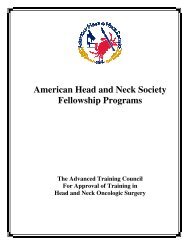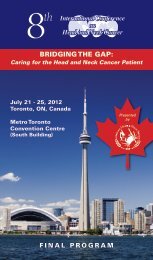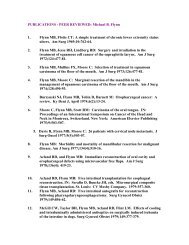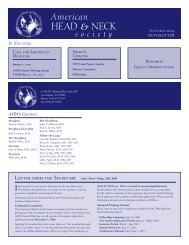Download - American Head and Neck Society
Download - American Head and Neck Society
Download - American Head and Neck Society
You also want an ePaper? Increase the reach of your titles
YUMPU automatically turns print PDFs into web optimized ePapers that Google loves.
Oral Papers<br />
Conclusions: This retrospective study provides new information on<br />
survival prediction for these patients <strong>and</strong> demonstrates the interaction<br />
of clinically relevant prognostic factors that reflect variation in disease<br />
biology <strong>and</strong> behavior.<br />
This data <strong>and</strong> unique analysis has identified the following as independent<br />
prognostic variables: Time to recurrence; Initial treatment modality, single<br />
or combined; Site of failure, local or regional. The relationship of these<br />
variables is not fixed as they have a dynamic interaction.<br />
S033<br />
TARGETING A TREATMENT-RESISTANT, MESENCHYMAL-LIKE<br />
SUBPOPULATION WITHIN HEAD AND NECK SQUAMOUS CELL<br />
CARCINOMAS. Devraj Basu, MD PhD, Thierry-Thien K Nguyen, MS,<br />
Kathleen T Montone, MD, Anil K Rustgi, MD, Min Xiao, MS, Gregory<br />
S Weinstein, MD, Meenhard Herlyn, DVM DSc; The University Of<br />
Pennsylvania, Philadelphia VA Medical Center, The Wistar Institute.<br />
A barrier to effective therapy for head <strong>and</strong> neck squamous cell<br />
carcinoma (HNSCC) is intrinsic drug resistance within discrete<br />
subpopulations among heterogeneous phenotypes present in a given<br />
tumor. We have previously identified a subpopulation that arises from<br />
epithelial to mesenchymal transition in vitro <strong>and</strong> in vivo in HNSCCs. This<br />
mesenchymal-like subset is resistant both conventional <strong>and</strong> epidermal<br />
growth factor receptor-targeted chemotherapies in comparison to the<br />
majority of malignant cells with predominantly epithelial differentiation.<br />
Coexistence of these dual phenotypes in vivo underscores the need<br />
to target both malignant populations to achieve tumor eradication.<br />
High throughput drug screening has recently identified the potassium<br />
ionophore compound salinomycin as effective against breast carcinoma<br />
cells with mesenchymal-like features. Here we evaluate whether<br />
salinomycin possesses enhanced activity against mesenchymal-like<br />
subsets within HNSCCs, relative to the widely used conventional<br />
cytotoxic agent cisplatin. Low concentrations of salinomycin inhibited<br />
growth <strong>and</strong> induced apoptosis of the mesenchymal-like subpopulation<br />
expressing low E-cadherin (Ecad-lo) <strong>and</strong> high vimentin, while the same<br />
subset showed resistance to cisplatin. Cisplatin treatment enriched the<br />
Ecad-lo subset in vitro among surviving HNSCC cells, while salinomycin<br />
effectively depleted this subpopulation, decreasing percentage of<br />
residual cells with the mesenchymal-like phenotype. Mesenchymallike<br />
cells surviving salinomycin exposure showed diminished growth<br />
potential, contrasting with unaffected growth of Ecad-lo cells surviving<br />
cisplatin treatment. In vivo salinomycin treatment of a mouse xenograft<br />
derived from an HNSCC clinical sample arrested tumor growth<br />
without leading to the enrichment of mesenchymal-like cells seen with<br />
conventional agents. Overall these results suggest that salinomycin<br />
has activity against mesenchymal-like subpopulations across multiple<br />
types of carcinomas. They further provide proof of concept that minority<br />
subpopulations possessing intrinsic drug resistance within HNSCCs may<br />
be approached with distinct pharmacologic targeting strategies.<br />
S034<br />
INTRAVASCULAR HUMAN SALIVARY CELL DELIVERY TO TREAT<br />
SALIVARY CELL LOSS IN A RODENT MODEL. Millie Surati, MD,<br />
Seth Purcell, Shay Soker, PhD, Tamer AbouShwareb, MS MD PhD,<br />
James J Yoo, MD PhD, Christopher A Sullivan, MD; Department of<br />
Otolaryngology-<strong>Head</strong> <strong>and</strong> <strong>Neck</strong> Surgery, Wake Forest University School<br />
of Medicine; Wake Forest Institute for Regenerative Medicine, Winston-<br />
Salem, NC USA.<br />
Objective: Radiation therapy for head <strong>and</strong> neck cancer causes salivary<br />
gl<strong>and</strong> cell loss <strong>and</strong> hypofunction. No cure exists for this condition.<br />
Replacement of lost salivary cells with a patient’s own cells could<br />
provide a physiologic solution to this problem. We aimed to determine<br />
the feasibility of therapeutic human salivary cell replacement using a<br />
novel intravascular cell delivery (IVCD) system in a rat model of salivary<br />
cell loss. Methods: Human subm<strong>and</strong>ibular gl<strong>and</strong> (SMG) cells were<br />
explanted from tissue, exp<strong>and</strong>ed in culture, <strong>and</strong> evaluated for phenotypic<br />
<strong>and</strong> functional markers. Cultured cells were labeled with PKH-67 <strong>and</strong><br />
suspended in complete medium. Three (3) male Sprague-Dawley rats<br />
underwent ligation of the right SMG. At 10 weeks, one (1) ligated rat<br />
SMG was harvested for histologic control. Normal rat SMG was used for<br />
comparison to ligated gl<strong>and</strong>s. The other two (2) rats underwent carotid<br />
artery catheterization <strong>and</strong> IVCD into the subm<strong>and</strong>ibular artery (1 million<br />
<strong>and</strong> 100,000 cells respectively). SMGs were harvested after 24 hours.<br />
www.ahns.info<br />
Histological assessment <strong>and</strong> cell characterization were performed.<br />
Radiated human SMG tissue was harvested during neck dissection,<br />
<strong>and</strong> histology was compared to ligated rat SMGs. Results: Cultured<br />
human SMG cells expressed functional markers at all passages. Ligated<br />
rat SMGs showed a decellularized tissue matrix comparable to human<br />
radiated salivary tissue. In IVCD specimens, PKH-67–labeled cells<br />
were widely dispersed in tissue; human phenotype <strong>and</strong> functional cell<br />
markers were identified in all IVCD cells. Conclusions: A rat SMG<br />
duct ligation model of cell loss achieves a picture that is histologically<br />
indistinguishable from irradiated human SMG gl<strong>and</strong>s. Directed IVCD<br />
to a damaged rat SMG delivers a full complement of functional human<br />
salivary cells that leave the intravascular space <strong>and</strong> are dispersed<br />
throughout a vascularized, decellularized target organ. Further study of<br />
salivary IVCD is warranted in an animal model of salivary hypofunction.<br />
S035<br />
SENSITIZATION OF HEAD AND NECK CANCER TO CISPLATIN<br />
THROUGH THE INHIBITION OF STAT3. Waleed M Abuzeid, MD,<br />
Samantha Davis, BS, Alice Tang, BS, Lindsay Saunders, BS, Jiayuh Lin,<br />
PhD, James R Fuchs, PhD, Carol R Bradford, MD, Thomas E Carey,<br />
PhD; University of Michigan <strong>and</strong> The Ohio State University.<br />
Objectives: Future advances in the treatment of cancer will involve<br />
disruption of the key molecules involved in tumor growth. Signal<br />
transducer <strong>and</strong> activator of transcription (STAT) proteins regulate<br />
key cellular fate decisions including differentiation, proliferation<br />
<strong>and</strong> apoptosis. STAT3, in particular, is a key mediator of oncogenic<br />
signaling. Over-expression of STAT3 induces tumor growth through<br />
up-regulation of downstream apoptosis inhibitors, facilitation of cell<br />
cycle progression <strong>and</strong> promotion of angiogenesis. STAT3 is activated<br />
in 82% of human head <strong>and</strong> neck squamous cell carcinomas (HNSCC).<br />
We hypothesized that targeted inhibition of STAT3 with a novel small<br />
molecule inhibitor (FLLL32) would induce marked cytotoxicity in<br />
HNSCC cells when used as a monotherapy <strong>and</strong> would also sensitize<br />
tumors to cisplatin chemotherapy. Methods: Western blot was used<br />
to determine STAT3 expression in two HNSCC cell lines, UM-SCC-29<br />
<strong>and</strong> -74B, <strong>and</strong> to confirm FLLL32-induced knock-down of STAT3. The<br />
LD50 for FLLL32 was determined for each cell line using cell proliferation<br />
assays. UM-SCC-29 cells were divided into 11 groups: no treatment<br />
controls, cisplatin monotherapy at doses of 25, 12.5, 6.25, 3.125 µM,<br />
monotherapy with FLLL32 (LD50 dose), combination therapy of FLLL32<br />
(LD50) with cisplatin at doses of 25, 12.5, 6.25, 3.125 <strong>and</strong> 1.562 µM.<br />
Cell proliferation was then assessed by 3 day MTT assay. Results:<br />
Both the UM-SCC-29 <strong>and</strong> -74B cell lines express STAT3 protein.<br />
Protein levels were significantly reduced in both cell lines following<br />
treatment with FLLL32. In UM-SCC-29, cisplatin monotherapy over<br />
72 hours suppressed tumor growth by 51%, 46%, 42% <strong>and</strong> 29%<br />
at 25, 12.5, 6.25 <strong>and</strong> 3.125 µM, respectively (p








